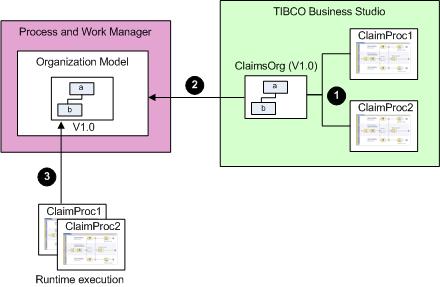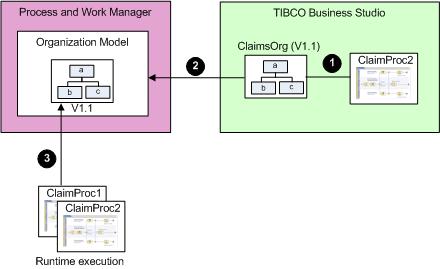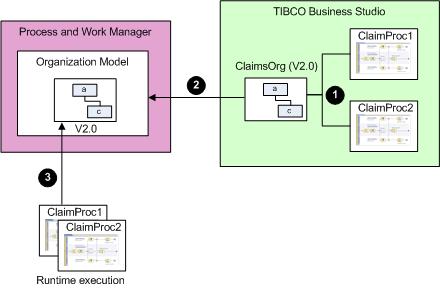How BPM Handles Organization Model Versions at Deployment
When an organization model is deployed to BPM, each major version is treated as a complete and separate organization model, and each minor version is treated as an additive update to the existing organization model with that major version number.
At runtime, a process executes against the accumulation of all deployed organization models belonging to the major version referenced in its process definition. For example, an organization model may have been deployed with version numbers, 1.1, 1.2 and 1.3. All processes that reference that organization will execute against organization model version 1.3.
The following example shows how organization model versioning can be used.
EasyAs Insurance is rolling out a BPM implementation, starting with Customer Services.

- The implementation defines two applications, ClaimProc1 and ClaimProc2, which involve departments a and b. These departments are modeled in the ClaimsOrg organization model, which is given a version number of V1.0. The major version number (1) is recorded in the ClaimProc1 and ClaimProc2 process definitions.
- The ClaimsOrg organization model and both ClaimProc applications are deployed to BPM.
- At runtime, both applications execute against V1.0 of the organization model.
Following some user testing, EasyAs decide that they need to change one of the processes to involve an additional department.
The ClaimsOrg organization model is modified to include department c. As this is an extension to the existing organization model, the version number is incremented to V1.1.
- ClaimProc2 is modified to use department c. ClaimProc1 does not involve department c, so does not need to be modified.
- The ClaimsOrg organization model and ClaimProc1 application are deployed to Process and Work Manager.
- At runtime, both ClaimProc applications execute against V1.1 of the organization model.
A company reorganization now occurs which results in department b being broken up.
The ClaimsOrg organization model is modified to remove department b. As this is a destructive change, the version number is incremented to a higher major version number, V2.0.
- ClaimProc2 is modified to remove its references to department b. ClaimProc1 must also be modified to reference the updated organization model (even though the application does not involve department b). The major version number (2) is recorded in the ClaimProc1 and ClaimProc2 process definitions.
- The ClaimsOrg organization model and both ClaimProc applications are deployed to Process and Work Manager.
- At runtime, both applications execute against V2.0 of the organization model.


